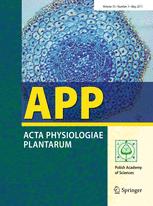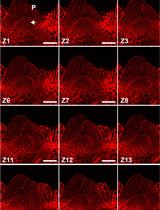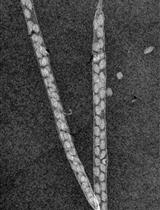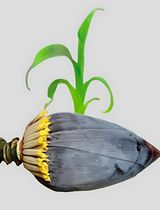- EN - English
- CN - 中文
In vitro Floral Induction of Cuscuta reflexa
大花菟丝子的体外成花诱导
发布: 2017年01月20日第7卷第2期 DOI: 10.21769/BioProtoc.2104 浏览次数: 8126
评审: Rainer MelzerAntoine DanonKenichi Shibuya
Abstract
Floral initiation and development in the angiosperms is the essential step on which the yield of the plant depends. Sometimes external climate or any abiotic stress hinders the floral initiation and ultimately affect the plant yield. Hence, in vitro floral induction and development can help to overcome the external climatic factor. Furthermore, the protocol for in vitro floral induction in the parasitic angiosperm like Cuscuta reflexa has not been reported yet. We have standardized the protocol for floral induction in the parasitic plant Cuscuta reflexa. In this study it is established that MMS (modified Murashige Skoog) media supplemented with 2 mg L-1 NAA (naphthalene acetic acid, plant growth regulator) and 2 mg L-1 2,4-D (2,4-dichlorophenoxy acetic acid, plant growth regulator) supported floral induction after shooting in vitro. Furthermore, we found that MMS media supplemented with 2 mg L-1 2,4-D rapidly induced floral buds directly from the nodal explants without any shoot elongation. This protocol will help the researcher to induce flower in vitro in the other angiosperm plants along with Cuscuta reflexa.
Keywords: Cuscuta reflexa (大花菟丝子)Background
Cuscuta reflexa is a parasitic angiosperm parasitizing on a huge number of angiosperms (Kuijt, 1969). The ability to cause severe damage and loss of yield in the host plant has made this species important for scientific study (Nun and Mayer, 1999). Most of the Cuscuta species are non chloroplastic except few which have functional chloroplasts (Hibberd et al., 1998). Development of seedlings from larger embryos of C. reflexa in white’s medium has been reported (Maheshweri and Baldev, 1961). Floral induction of C. reflexa in short day period as well as dark conditions has been seen in vitro (Baldev, 1962). In vitro floral induction of Cuscuta japonica in short day conditions has also been established by Furuhashi et al. (1991).
Specifically, floral induction and effect of growth regulators on floral induction of C. reflexa has not yet been studied. A complete tissue culture system for Cuscuta trifolli in liquid MS culture has been reported so far (Bakos et al., 1995). The floral induction in C. reflexa on modified white’s medium, subjecting the plant to different light and dark conditions, has been studied years back (Baldev, 1962). Here we have shown a complete in vitro culture system for floral induction in C. reflexa. Concentration of 2,4-D played a significant role in floral induction. Supplementation of NAA along with 2,4-D induces shoot followed by flower, but supplementation of only 2,4-D induces flower directly from nodal explants without showing any stem elongation. This result is very attractive and is showing the importance of 2,4-D in floral induction of this plant.
Materials and Reagents
- Pipette tips (Tarsons)
- 5 ml syringe (Himedia)
- 0.45 micron filter (Himedia)
- Stem explants of Cuscuta reflexa
- Murashige & Skoog (MS) basal medium (Murashige and Skoog, 1962) (Sigma-Aldrich, catalog number: M5519 )
- Sucrose (Sigma-Aldrich, catalog number: S0389 )
- Gamborg’s vitamin solution (Sigma-Aldrich, catalog number: G1019 )
- Agar (HiMedia Laboratories, catalog number: PCT0901 )
- 2,4-dichlorophenoxyacetic acid (2,4-D) (Sigma-Aldrich, catalog number: D7299 )
- Naphthalene acetic acid (NAA) (Sigma-Aldrich, catalog number: N0640 )
- Sodium hydroxide (NaOH) (Sigma-Aldrich, catalog number: 221465 )
- Mercury(II) chloride (HgCl2) (0.01%) (EMD Millipore, catalog number: 104419 )
- Bavistin (1% solution, Swat agro chemicals)
- Ethanol (EMD Millipore, catalog number: 100983 )
- MMS (modified Murashige Skoog) media (see Recipes)
- 2,4-D stock solution (see Recipes)
- NAA stock solution (see Recipes)
- Floral induction media-1 (see Recipes)
- Floral induction media-2 (see Recipes)
- HgCl2 (0.1%) (see Recipes)
- Bavistin solution (1%) (see Recipes)
Equipment
- 0.5-10 μl pipette (Transferpette®) (BRAND, catalog number: 704770 )
- 20-200 μl pipette (Transferpette®) (BRAND, catalog number: 704778 )
- 100-1,000 μl pipette (Transferpette®) (BRAND, catalog number: 704780 )
- Beaker (200 ml, Borosil)
- Laminar hood (Thermo Fisher Scientific)
- Conical flask (150 ml, Borosil)
- Culture room (Daihan LabTech India, model: LGC-S201 )
- Autoclave
- Forceps (ACE Surgical Supply Company, catalog number: 20-000-48 )
- Oven (Hicon India)
- Water distillation unit (Mars Scientific Instruments, catalog number: BASIC/pH4 & XL )
- pH meter (CD Hightech, model: APX 175 E )
- Weighing machine (Sartorius, model: BSA224S-CW )
- Scissor (general cutting scissor)
Procedure
文章信息
版权信息
© 2017 The Authors; exclusive licensee Bio-protocol LLC.
如何引用
Das, P. and Sahoo, S. (2017). In vitro Floral Induction of Cuscuta reflexa. Bio-protocol 7(2): e2104. DOI: 10.21769/BioProtoc.2104.
分类
植物科学 > 植物发育生物学 > 形态建成
细胞生物学 > 组织分析 > 组织分离
您对这篇实验方法有问题吗?
在此处发布您的问题,我们将邀请本文作者来回答。同时,我们会将您的问题发布到Bio-protocol Exchange,以便寻求社区成员的帮助。
Share
Bluesky
X
Copy link














